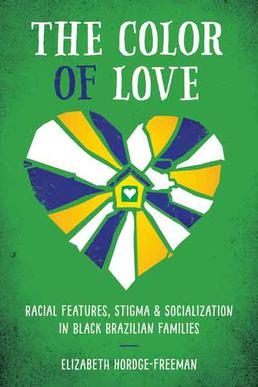A race is a categorization of humans based on shared physical or social qualities into groups generally viewed as distinct within a given society. The term came into common usage during the 16th century, when it was used to refer to groups of various kinds, including those characterized by close kinship relations. By the 17th century, the term began to refer to physical (phenotypical) traits, and then later to national affiliations. Modern science regards race as a social construct, an identity which is assigned based on rules made by society. While partly based on physical similarities within groups, race does not have an inherent physical or biological meaning. The concept of race is foundational to racism, the belief that humans can be divided based on the superiority of one race over another.
Miscegenation is the interbreeding of people who are considered to be members of different races. The word, now usually considered pejorative, is derived from a combination of the Latin terms miscere and genus ("race") from the Hellenic γένος. The word first appeared in Miscegenation: The Theory of the Blending of the Races, Applied to the American White Man and Negro, a pretended anti-abolitionist pamphlet David Goodman Croly and others published anonymously in advance of the 1864 U.S. presidential election. The term came to be associated with laws that banned interracial marriage and sex, which were known as anti-miscegenation laws.
Racial discrimination is any discrimination against any individual on the basis of their skin color, race or ethnic origin. Individuals can discriminate by refusing to do business with, socialize with, or share resources with people of a certain group. Governments can discriminate in a de facto fashion or explicitly in law, for example through policies of racial segregation, disparate enforcement of laws, or disproportionate allocation of resources. Some jurisdictions have anti-discrimination laws which prohibit the government or individuals from discriminating based on race in various circumstances. Some institutions and laws use affirmative action to attempt to overcome or compensate for the effects of racial discrimination. In some cases, this is simply enhanced recruitment of members of underrepresented groups; in other cases, there are firm racial quotas. Opponents of strong remedies like quotas characterize them as reverse discrimination, where members of a dominant or majority group are discriminated against.
Multiracial people are people of more than one race. A variety of terms have been used both historically and presently for mixed race people in a variety of contexts, including multiethnic, polyethnic, occasionally bi-ethnic, Métis, Muwallad, Colored, Dougla, half-caste, ʻafakasi, mestizo, Melungeon, quadroon, octoroon, sambo/zambo, Eurasian, hapa, hāfu, Garifuna, pardo, and Guran. A number of these terms are now considered offensive, in addition to those that were initially coined for pejorative use.
The Caucasian race is an obsolete racial classification of human beings based on a now-disproven theory of biological race. The Caucasian race was historically regarded as a biological taxon which, depending on which of the historical race classifications was being used, usually included ancient and modern populations from all or parts of Europe, Western Asia, Central Asia, South Asia, North Africa, and the Horn of Africa.
Kenneth Bancroft Clark and Mamie Phipps Clark were American psychologists who as a married team conducted research among children and were active in the Civil Rights Movement. They founded the Northside Center for Child Development in Harlem and the organization Harlem Youth Opportunities Unlimited (HARYOU). Kenneth Clark was also an educator and professor at City College of New York, and first Black president of the American Psychological Association.
Whiteness studies is the study of the structures that produce white privilege, the examination of what whiteness is when analyzed as a race, a culture, and a source of systemic racism, and the exploration of other social phenomena generated by the societal compositions, perceptions and group behaviors of white people. It is an interdisciplinary arena of inquiry that has developed beginning in the United States from white trash studies and critical race studies, particularly since the late 20th century. It is focused on what proponents describe as the cultural, historical and sociological aspects of people identified as white, and the social construction of "whiteness" as an ideology tied to social status.
Robin Washington is an American journalist and filmmaker, born in Chicago in 1956. As a journalist and editor, he was worked for newspapers in Boston and Duluth, Minnesota, as well as for NPR. He has made documentaries about the civil rights movement and the lives of African Americans in the United States.

Ethnic pornography is a genre of pornography featuring performers of specific ethnic groups, or depictions of interracial sexual activity. Productions can feature any type of ethnic group, such as White, Asian, Middle Eastern, Latino, Black, or Native American.
Identifying human races in terms of skin color, at least as one among several physiological characteristics, has been common since antiquity. Such divisions appeared in rabbinical literature and in early modern scholarship, usually dividing humankind into four or five categories, with color-based labels: red, yellow, black, white, and sometimes brown. It was long recognized that the number of categories is arbitrary and subjective, and different ethnic groups were placed in different categories at different points in time. François Bernier (1684) doubted the validity of using skin color as a racial characteristic, and Charles Darwin (1871) emphasized the gradual differences between categories. Today there is broad agreement among scientists that typological conceptions of race have no scientific basis.
Joel Augustus Rogers was a Jamaican-American author, journalist, and historian who focused on the history of Africa; as well as the African diaspora. After settling in the United States in 1906, he lived in Chicago and then New York City. He became interested in the history of African Americans in the United States. His research spanned the academic fields of history, sociology and anthropology. He challenged prevailing ideas about scientific racism and the social construction of race, demonstrated the connections between civilizations, and traced achievements of ethnic Africans, including some with mixed European ancestry. He was one of the earliest popularizers of African and African-American history in the 20th century. His book World's Great Men of Color was recognized by John Henrik Clarke as being his greatest achievement.
Interracial adoption refers to the act of placing a child of one racial or ethnic group with adoptive parents of another racial or ethnic group.
Racial passing occurs when a person classified as a member of a racial group is accepted or perceived ("passes") as a member of another. Historically, the term has been used primarily in the United States to describe a black or brown person or of multiracial ancestry who assimilated into the white majority to escape the legal and social conventions of racial segregation and discrimination.

France Winddance Twine is a Black and Native American sociologist, ethnographer, visual artist, and documentary filmmaker. Twine's research has made significant contributions to interdisciplinary research in gender and sexuality studies, racism/anti-racism, feminist studies, science and technology studies, British cultural studies, and qualitative research methods. She has conducted field research in Brazil, the UK, and the United States on race, racism, and anti-racism and has published 11 books and more than 80 articles, review essays, and books on these topics. In 2020, she was awarded the Distinguished Career Award by the Race, Class, and Gender section of the American Sociological Association for her intellectual, innovative, and creative contributions to sociology. Twine is the first sociologist to publish an ethnography on everyday racism in rural Brazil after the end of military dictatorship during the "abertura".
Internalized racism is a form of internalized oppression, defined by sociologist Karen D. Pyke as the "internalization of racial oppression by the racially subordinated." In her study The Psychology of Racism, Robin Nicole Johnson emphasizes that internalized racism involves both "conscious and unconscious acceptance of a racial hierarchy in which whites are consistently ranked above people of color." These definitions encompass a wide range of instances, including, but not limited to, belief in negative stereotypes, adaptations to white cultural standards, and thinking that supports the status quo.

Randall LeRoy Kennedy is an American law professor at Harvard University and author. He is the Michael R. Klein Professor of Law and his research focuses on the intersection of racial conflict and legal institutions in American life. He specializes in contracts, freedom of expression, race relations law, civil rights legislation, and the Supreme Court.
Multiracial Americans are Americans who have mixed ancestry of two or more races. The term may also include Americans of mixed race ancestry who self-identify with just one group culturally and socially. In the 2010 United States census, approximately 9 million individuals or 3.2% of the population, self-identified as multiracial. There is evidence that an accounting by genetic ancestry would produce a higher number. Historical reasons are said to have created a racial caste such as the European-American suppression of Native Americans, often led people to identify or be classified by only one ethnicity, generally that of the culture in which they were raised. Prior to the mid-20th century, many people hid their multiracial heritage because of racial discrimination against minorities. While many Americans may be considered multiracial, they often do not know it or do not identify so culturally, any more than they maintain all the differing traditions of a variety of national ancestries.
Dr. Yaba Blay is a Ghanaian-American professor, scholar-activist, public speaker, cultural worker, and consultant. She is originally from Ghana, West Africa, and was raised in New Orleans, Louisiana, United States. Her scholarship, work, and practice centers on the lived experiences of Black women and girls, with a particular focus on identity politics and beauty practices. Lauded by O Magazine for her social media activism, she has launched several viral campaigns, including Locks of Love, #PrettyPeriod, and #ProfessionalBlackGirl, in her multi-platform digital community.

Concepts of race and sexuality have interacted in various ways in different historical contexts. While partially based on physical similarities within groups, race is understood by scientists to be a social construct rather than a biological reality. Human sexuality involves biological, erotic, physical, emotional, social, or spiritual feelings and behaviors.

The Color of Love: Racial Features, Stigma, and Socialization in Black Brazilian Families is a book by sociologist Elizabeth Hordge-Freeman published in 2015 by the University of Texas Press. The book details how racial hierarchies impact family interactions and treatment in Brazil and how these actions impact the well-being of the family members.




